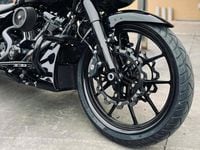This Honda CBR600RR engine has eight exhaust valves and they are quite small—22mm in diameter. All of the valves are exposed to combustion heat, but exhaust valves are heated twice. When the valve opens and exhaust gas begins to flow out from under it, the valve is heated not only on the top of its head by combustion itself but the back side of it is heated as well by exhaust gas, whose temperature can be as high as 1,700 degrees Fahrenheit.
In the early days of motorcycle race tuning, engineers would run an engine without an exhaust pipe on it and look up the port to see if the valve was glowing red hot. The hotter the valve gets, the more likely it is to heat the incoming fresh charge for the next combustion cycle. After the spark lights the charge and it is compressed further by the expanding flame kernel, some part of the unburned gas around the outside of the combustion chamber, particularly that which is heated by the exhaust valve, will detonate or knock.
Because this particular valve is small, the distance from the hottest part of it to the seat—the part of the valve that seals against the cylinder head—is very short, so heat can flow from the center of the valve out to the water-cooled seat in the head. But the bigger you make an engine, the distance that heat has to flow out of the valve to the cooler seat becomes larger and the valve operates hotter.
We’re really fortunate in sportbike engines that their exhaust valves are such cute little guys because their short heat path means that their survival is pretty well guaranteed. In bigger engines, sometimes you’ll see chunks taken out of the head of an exhaust valve. A crumb of carbon holds the valve open slightly, leakage of combustion gas bypasses the valve, heats it up, and a flame channel develops. It looks like somebody went after the poor valve with a torch.
In an air-cooled engine, life is very hard for an exhaust valve. In a water-cooled engine, it is more of a vacation.
/cloudfront-us-east-1.images.arcpublishing.com/octane/A6O3TEZF45BVFG2KKOUMPWEYM4.jpg)
/cloudfront-us-east-1.images.arcpublishing.com/octane/MHVFMH2YN5DT3EOZPLXKNFP3VM.jpg)
/cloudfront-us-east-1.images.arcpublishing.com/octane/VILA5L7CTBGOJGDKM2YAOCR6VU.jpg)
/cloudfront-us-east-1.images.arcpublishing.com/octane/GZMZRTYRS5A75G2EJDDGXLJEEE.jpg)
/cloudfront-us-east-1.images.arcpublishing.com/octane/6KWAL3TFNJBGTJMJSKQ2C6I3IY.jpg)
/cloudfront-us-east-1.images.arcpublishing.com/octane/GK5I5R3X7JCABGCKAKT4XY2K7U.jpg)


/cloudfront-us-east-1.images.arcpublishing.com/octane/RGUT3Y65IFGDFMLHQ3U7G5UUQE.jpg)

/cloudfront-us-east-1.images.arcpublishing.com/octane/37CSHD6CKRHYXHRB67EOLDS6XM.jpg)
/cloudfront-us-east-1.images.arcpublishing.com/octane/FYB7GKDGLVE3JKXMM75JTG2RYA.jpg)
/cloudfront-us-east-1.images.arcpublishing.com/octane/3ECVMM622VAZHIOLI6Q6ILWULU.jpg)


/cloudfront-us-east-1.images.arcpublishing.com/octane/UIZQ7VXRCRHBVDFK5RFJIEBBAU.jpg)

/cloudfront-us-east-1.images.arcpublishing.com/octane/QXBJ4CVEEBG2BF5O3TOPIGP7ZE.jpg)


/cloudfront-us-east-1.images.arcpublishing.com/octane/HGNDJUKK4FHNTP5XEYYHWVW6NI.jpg)
/cloudfront-us-east-1.images.arcpublishing.com/octane/GDGQOIQBDBCXLIUZUEMCP2C5ZE.jpg)
/cloudfront-us-east-1.images.arcpublishing.com/octane/M6Z3IHJEAZE4XDQGCFN7YPJEOA.jpg)
/cloudfront-us-east-1.images.arcpublishing.com/octane/L6GYTNOQB5FOXPUZIQZYQSJ3PI.jpg)